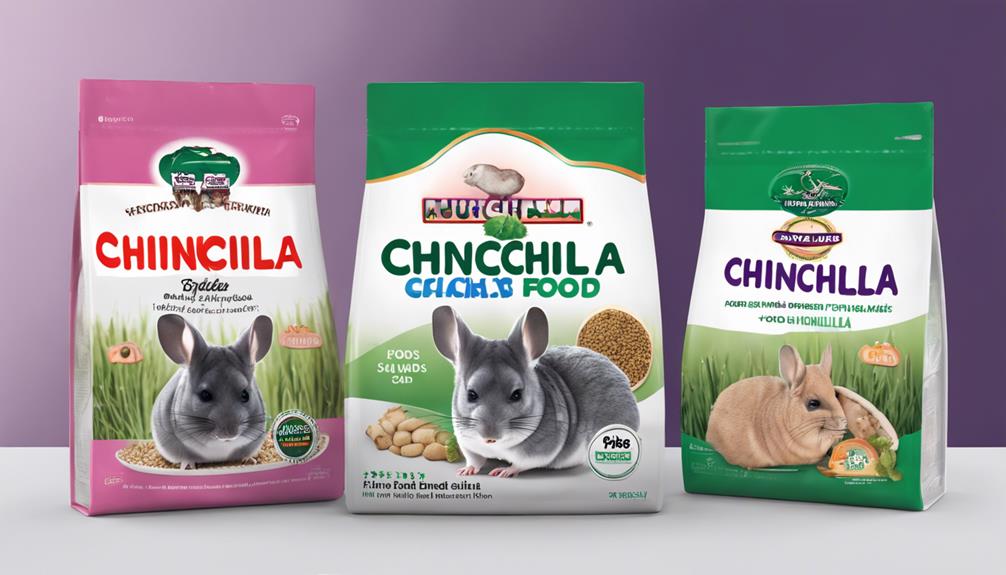What to Do When Switching Chinchilla Food Brands Safely

Switching chinchilla food brands should be done gradually over a period of 7-10 days to prevent digestive upset. Start by mixing a small amount of the new food with the old food, gradually increasing the ratio of new to old food each day. Monitor your chinchilla for any signs of digestive issues such as diarrhea or decreased appetite during the transition period. If you notice any problems, slow down the transition process or consult a veterinarian for advice. Remember to provide fresh water and hay at all times to ensure your chinchilla stays hydrated and maintains good digestive health.
It's important to choose a high-quality chinchilla food that meets your pet's nutritional needs. Look for a food that is specifically formulated for chinchillas and contains a mix of pellets, hay, and dried fruits or vegetables. Avoid foods that are high in fat, sugar, or artificial additives, as these can be harmful to your chinchilla's health. Always check the ingredient list and nutritional information before making a switch to ensure you are providing the best diet for your furry friend.
Assess Current Food and Health
Evaluating your chinchilla's current food and health is essential before making any changes in their diet to guarantee a smooth shift to a new food brand. Assessing behavior and weight monitoring are key aspects of this evaluation process.
Begin by observing your chinchilla's behavior during feeding times. Are they enthusiastic and energetic, or are they showing signs of disinterest or lethargy? Changes in behavior can often indicate underlying health issues or a lack of nutrition in their current diet.
Additionally, regular weight monitoring is important to tracking your chinchilla's overall health. Sudden weight loss or gain can signify potential health concerns that need to be addressed before considering a switch in food brands.
Research New Food Brand
When considering a new food brand for your chinchilla, it's important to check the ingredient differences between the current and prospective options.
Begin the change by gradually mixing the new food with the old to prevent any digestive upsets for your furry friend.
This method allows your chinchilla to acclimate to the new brand while ensuring their health and well-being are maintained.
Check Ingredient Differences
To guarantee a smooth change when switching chinchilla food brands, thoroughly examine the ingredient disparities of the new food brand through diligent research. Start by comparing the nutritional values of both the current and prospective food brands.
Look into the ingredient sourcing practices of the new brand to make certain quality and safety for your chinchilla. Understanding the differences in ingredients will help you make an informed decision that prioritizes your pet's health and well-being.
Gradually Mix Foods
Begin the switch to a new chinchilla food brand by systematically blending the current and prospective foods, guaranteeing a seamless shift in your pet's diet.
When making the switch to your chinchilla's food, consider the following:
- Food Preferences: Take note of your chinchilla's preferences to make sure they enjoy the new food.
- Health Benefits: Research the nutritional value and health benefits of the new food brand.
- Taste Testing: Introduce the new food gradually to allow your chinchilla to adapt to the taste.
- Nutritional Value: Guarantee the new food meets your chinchilla's nutritional requirements for a balanced diet.
Gradual Transition Plan

When switching to a new food brand for your chinchilla, remember the importance of a gradual change plan. Slowly introducing the new food will allow your pet to adjust without digestive upsets.
Monitor your chinchilla's reaction closely and adjust portions accordingly to guarantee a smooth and safe switch.
Slowly Introduce New Food
How can you smoothly shift your chinchilla to a new food brand without causing digestive upset? Chinchillas have sensitive digestive systems and abrupt changes can lead to issues. Follow these steps to guarantee a seamless change:
- Mix old and new: Blend the current and new food to gradually introduce the new brand.
- Increase proportion: Slowly increase the amount of new food in the mix over 7-10 days.
- Monitor closely: Watch for any signs of digestive discomfort or refusal to eat.
- Consult a vet: If your chinchilla experiences persistent issues, seek advice from a veterinarian familiar with chinchilla care.
Monitor Chinchilla's Reaction
To guarantee a smooth adjustment to the new food brand for your chinchilla, attentively observe their response during this gradual shift in diet. Your furry friend may exhibit various behaviors as they adapt to the new food. Watch for changes in eating habits, energy levels, and overall demeanor. Any signs of distress or discomfort should be noted and addressed promptly.
Additionally, tracking your chinchilla's weight throughout the changeover period is pivotal. Sudden weight loss or gain could indicate issues with the new food or the adjustment process. By keenly observing your chinchilla's behavior and monitoring their weight, you can assure that the changeover to the new food brand is successful and beneficial for your beloved pet.
Adjust Portions Accordingly
To shift your chinchilla safely to the new food brand, adjust the portions gradually according to a structured plan. When adapting your chinchilla's diet, it's crucial to do so with care and attention. Here are four essential steps to help you navigate this process smoothly:
- Start Slow: Begin by mixing a small amount of the new food with the old food.
- Increase Gradually: Over the course of 7-10 days, slowly increase the proportion of the new food in their diet.
- Observe Closely: Monitor your chinchilla's reaction to the new food, making sure they're consuming it without any issues.
- Monitor Weight: Keep an eye on your chinchilla's weight during the shift period to make sure they're maintaining a healthy balance.
Monitor Chinchilla's Response

Observe your chinchilla's behavior closely when changing to a new food brand to guarantee a safe and positive response. Monitoring your chinchilla's behavior is critical during this shift period. Keep a keen eye on how your chinchilla reacts to the new food. Changes in behavior such as decreased appetite, lethargy, or unusual aggression could indicate that the new food isn't agreeing with your pet.
Additionally, assess your chinchilla's stools regularly. Any significant changes in stool consistency, color, or frequency may signal digestive issues or intolerance to the new food.
It is essential to remember that each chinchilla is unique, and their responses to food changes may vary. By closely monitoring behavior and stool quality, you can quickly identify any adverse reactions and take appropriate action. If you notice any concerning signs, consult with a veterinarian promptly.
Your chinchilla's health and well-being should always be a top priority when introducing a new food brand.
Hydration Importance
Maintaining proper hydration for your chinchilla is paramount to ensuring its overall health and well-being. Adequate water consumption is essential for your furry friend's vitality and longevity. Here are some hydration tips and benefits to keep in mind:
- Monitor Water Consumption: Pay attention to how much water your chinchilla is drinking daily. Changes in water intake could signal an underlying health issue.
- Provide Fresh Water Daily: Guarantee your chinchilla has access to fresh, clean water at all times. Stale water can discourage drinking.
- Offer Hydrating Foods: Incorporate fresh vegetables and fruits with high water content into your chinchilla's diet to boost hydration levels.
- Prevent Dehydration: Be vigilant during hot weather or if your chinchilla is unwell, as these situations can increase the risk of dehydration.
Seek Veterinary Advice

Seeking veterinary guidance is important for ensuring the best health and well-being of your chinchilla. When contemplating dietary changes or shifting to a new food brand, consulting with a veterinarian is paramount. These professionals possess the expertise to provide tailored nutritional recommendations based on your chinchilla's specific needs.
A consultation with a vet allows for a thorough assessment of your chinchilla's current health status and dietary requirements. They can offer valuable insights into the nutritional content of different food brands, ensuring that your chinchilla receives a balanced diet. Additionally, veterinarians can advise on the gradual introduction of new foods to prevent digestive issues or nutritional imbalances.
Finalize New Diet Adjustment
When considering finalizing the adjustment to your chinchilla's new diet, meticulous attention to detail is key in ensuring a smooth change and best health outcomes. To successfully complete the change, follow these essential steps:
- Dietary Supplements: Guarantee your chinchilla's new diet provides all necessary nutrients. Consider consulting with a veterinarian to determine if any additional dietary supplements are required for best health.
- Hydration: Monitor your chinchilla's water intake closely. Adequate hydration is essential for your pet's well-being. Make sure fresh water is always available.
- Exercise Routine: Incorporate regular playtime and exercise into your chinchilla's daily routine. Physical activity is crucial for maintaining a healthy weight and promoting overall wellness.
- Environment Changes: Create a comfortable and stimulating environment for your chinchilla. Adjust cage accessories, bedding, and toys to keep your pet engaged and happy during the diet adjustment period.
Frequently Asked Questions
Can Chinchillas Be Picky Eaters and Refuse to Eat the New Food Brand During the Transition Process?
When switching chinchilla food brands, taste preferences and chinchilla behavior play a role in change challenges. Chinchillas can be picky eaters, sticking to familiar dietary habits. Encourage acceptance by mixing old and new food gradually. Your patience is key.
How Long Should the Gradual Transition Plan Typically Last Before Fully Switching to the New Food Brand?
When switching chinchilla food brands, the shift timeline varies based on chinchilla preferences. Make a gradual change over 1-2 weeks, balancing nutritional needs with taste preferences. Remember, patience is key to guaranteeing a successful shift that benefits your furry friend's health.
Are There Any Specific Signs or Symptoms to Look Out for to Indicate That the Chinchilla Is Not Responding Well to the New Food Brand?
As you observe your chinchilla adjusting to the new food brand, be vigilant for signs of distress like changes in appetite, energy levels, or stool quality. Any concerning symptoms should prompt a vet visit for expert advice.
How Often Should a Chinchilla's Hydration Levels Be Monitored During the Transition to Ensure They Are Staying Properly Hydrated?
To guarantee your chinchilla's health stays at its best during the change, monitor their hydration regularly. Keep a sharp eye on their water intake and habits. Adjust as needed based on the change timeline and your chinchilla's appetite.
Are There Any Potential Risks or Complications That May Arise From Switching Chinchilla Food Brands, Even When Following a Safe and Gradual Transition Plan?
When switching chinchilla food brands, potential risks or complications can arise, even with a safe switch plan. Some chinchillas, especially picky eaters, may refuse to eat the new food brand. Monitor signs of refusal or dehydration carefully.











